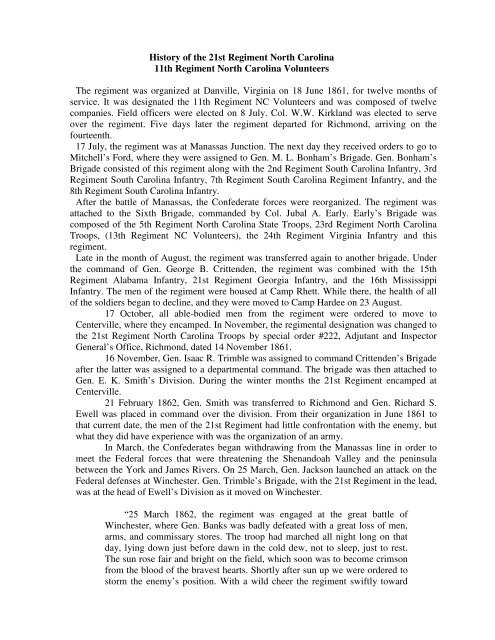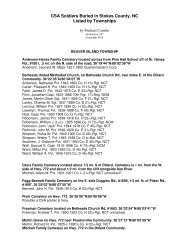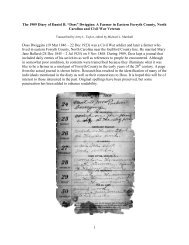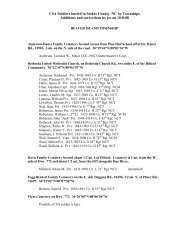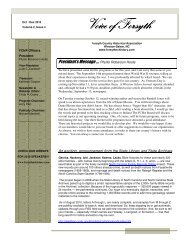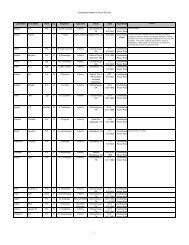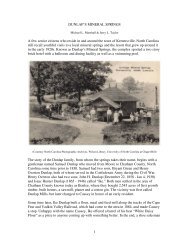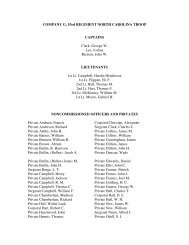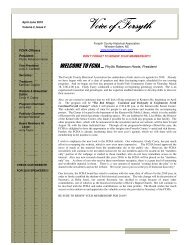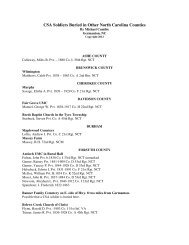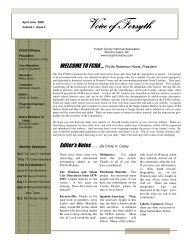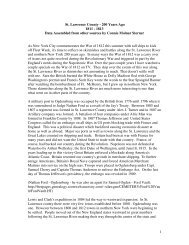History of the 21st Regiment North Carolina 11th Regiment North ...
History of the 21st Regiment North Carolina 11th Regiment North ...
History of the 21st Regiment North Carolina 11th Regiment North ...
Create successful ePaper yourself
Turn your PDF publications into a flip-book with our unique Google optimized e-Paper software.
<strong>History</strong> <strong>of</strong> <strong>the</strong> <strong>21st</strong> <strong>Regiment</strong> <strong>North</strong> <strong>Carolina</strong><br />
<strong>11th</strong> <strong>Regiment</strong> <strong>North</strong> <strong>Carolina</strong> Volunteers<br />
The regiment was organized at Danville, Virginia on 18 June 1861, for twelve months <strong>of</strong><br />
service. It was designated <strong>the</strong> <strong>11th</strong> <strong>Regiment</strong> NC Volunteers and was composed <strong>of</strong> twelve<br />
companies. Field <strong>of</strong>ficers were elected on 8 July. Col. W.W. Kirkland was elected to serve<br />
over <strong>the</strong> regiment. Five days later <strong>the</strong> regiment departed for Richmond, arriving on <strong>the</strong><br />
fourteenth.<br />
17 July, <strong>the</strong> regiment was at Manassas Junction. The next day <strong>the</strong>y received orders to go to<br />
Mitchell’s Ford, where <strong>the</strong>y were assigned to Gen. M. L. Bonham’s Brigade. Gen. Bonham’s<br />
Brigade consisted <strong>of</strong> this regiment along with <strong>the</strong> 2nd <strong>Regiment</strong> South <strong>Carolina</strong> Infantry, 3rd<br />
<strong>Regiment</strong> South <strong>Carolina</strong> Infantry, 7th <strong>Regiment</strong> South <strong>Carolina</strong> <strong>Regiment</strong> Infantry, and <strong>the</strong><br />
8th <strong>Regiment</strong> South <strong>Carolina</strong> Infantry.<br />
After <strong>the</strong> battle <strong>of</strong> Manassas, <strong>the</strong> Confederate forces were reorganized. The regiment was<br />
attached to <strong>the</strong> Sixth Brigade, commanded by Col. Jubal A. Early. Early’s Brigade was<br />
composed <strong>of</strong> <strong>the</strong> 5th <strong>Regiment</strong> <strong>North</strong> <strong>Carolina</strong> State Troops, 23rd <strong>Regiment</strong> <strong>North</strong> <strong>Carolina</strong><br />
Troops, (13th <strong>Regiment</strong> NC Volunteers), <strong>the</strong> 24th <strong>Regiment</strong> Virginia Infantry and this<br />
regiment.<br />
Late in <strong>the</strong> month <strong>of</strong> August, <strong>the</strong> regiment was transferred again to ano<strong>the</strong>r brigade. Under<br />
<strong>the</strong> command <strong>of</strong> Gen. George B. Crittenden, <strong>the</strong> regiment was combined with <strong>the</strong> 15th<br />
<strong>Regiment</strong> Alabama Infantry, <strong>21st</strong> <strong>Regiment</strong> Georgia Infantry, and <strong>the</strong> 16th Mississippi<br />
Infantry. The men <strong>of</strong> <strong>the</strong> regiment were housed at Camp Rhett. While <strong>the</strong>re, <strong>the</strong> health <strong>of</strong> all<br />
<strong>of</strong> <strong>the</strong> soldiers began to decline, and <strong>the</strong>y were moved to Camp Hardee on 23 August.<br />
17 October, all able-bodied men from <strong>the</strong> regiment were ordered to move to<br />
Centerville, where <strong>the</strong>y encamped. In November, <strong>the</strong> regimental designation was changed to<br />
<strong>the</strong> <strong>21st</strong> <strong>Regiment</strong> <strong>North</strong> <strong>Carolina</strong> Troops by special order #222, Adjutant and Inspector<br />
General’s Office, Richmond, dated 14 November 1861.<br />
16 November, Gen. Isaac R. Trimble was assigned to command Crittenden’s Brigade<br />
after <strong>the</strong> latter was assigned to a departmental command. The brigade was <strong>the</strong>n attached to<br />
Gen. E. K. Smith’s Division. During <strong>the</strong> winter months <strong>the</strong> <strong>21st</strong> <strong>Regiment</strong> encamped at<br />
Centerville.<br />
21 February 1862, Gen. Smith was transferred to Richmond and Gen. Richard S.<br />
Ewell was placed in command over <strong>the</strong> division. From <strong>the</strong>ir organization in June 1861 to<br />
that current date, <strong>the</strong> men <strong>of</strong> <strong>the</strong> <strong>21st</strong> <strong>Regiment</strong> had little confrontation with <strong>the</strong> enemy, but<br />
what <strong>the</strong>y did have experience with was <strong>the</strong> organization <strong>of</strong> an army.<br />
In March, <strong>the</strong> Confederates began withdrawing from <strong>the</strong> Manassas line in order to<br />
meet <strong>the</strong> Federal forces that were threatening <strong>the</strong> Shenandoah Valley and <strong>the</strong> peninsula<br />
between <strong>the</strong> York and James Rivers. On 25 March, Gen. Jackson launched an attack on <strong>the</strong><br />
Federal defenses at Winchester. Gen. Trimble’s Brigade, with <strong>the</strong> <strong>21st</strong> <strong>Regiment</strong> in <strong>the</strong> lead,<br />
was at <strong>the</strong> head <strong>of</strong> Ewell’s Division as it moved on Winchester.<br />
“25 March 1862, <strong>the</strong> regiment was engaged at <strong>the</strong> great battle <strong>of</strong><br />
Winchester, where Gen. Banks was badly defeated with a great loss <strong>of</strong> men,<br />
arms, and commissary stores. The troop had marched all night long on that<br />
day, lying down just before dawn in <strong>the</strong> cold dew, not to sleep, just to rest.<br />
The sun rose fair and bright on <strong>the</strong> field, which soon was to become crimson<br />
from <strong>the</strong> blood <strong>of</strong> <strong>the</strong> bravest hearts. Shortly after sun up we were ordered to<br />
storm <strong>the</strong> enemy’s position. With a wild cheer <strong>the</strong> regiment swiftly toward
<strong>the</strong> enemy behind stone walls, and were met with terrific fire <strong>of</strong> infantry and<br />
grape shot. The day was won with <strong>the</strong> most exalted courage and desperate<br />
charge.<br />
I was severely wounded and left on <strong>the</strong> field, and <strong>the</strong> sight which<br />
<strong>the</strong>re presented itself can never be forgotten. Around stood several pieces <strong>of</strong><br />
artillery deserted by <strong>the</strong> enemy. Many Federals and Confederates lay dead,<br />
wounded and dying around me.<br />
Col. Kirkland, while waving his sword and cheering on his men, was<br />
shot through <strong>the</strong> thigh but did not leave <strong>the</strong> field. Lt. Col. Pepper lay mortally<br />
wounded, but still cheering his men to victory. My heart still bleeds when I<br />
think <strong>of</strong> our revered Captain J.C. Hedgcock, who was mortally wounded,<br />
pierced by half a dozen balls or more. A braver or truer man than that young<br />
lawyer was never sent to <strong>the</strong> field <strong>of</strong> battle. He and gallant Pepper sleep in <strong>the</strong><br />
cemetery at Winchester, with many <strong>of</strong> <strong>the</strong>ir brave comrades.”<br />
During <strong>the</strong> battle that morning, <strong>the</strong> regiment suffered <strong>the</strong> loss <strong>of</strong> twenty-one men<br />
dead and fifty-nine men wounded. After this battle, <strong>the</strong> 1st Battalion <strong>North</strong> <strong>Carolina</strong><br />
Sharpshooters became an independent unit in Trimble’s Brigade.<br />
When Federal troops, under <strong>the</strong> command <strong>of</strong> Gen. James Shield, moved from<br />
Fredericksburg toward <strong>the</strong> Shenandoah Valley, and a second force under Gen. John C.<br />
Fremont moved to <strong>the</strong> south branch <strong>of</strong> <strong>the</strong> Shenandoah River, Jackson concentrated his army<br />
to Winchester. Jackson’s men rebuffed Fremont at Cross Keys on 8 June. Losses were two<br />
men killed and eleven wounded.<br />
Leaving Trimble to oversee Fremont, Jackson turned on Shield’s force at Port<br />
Republic and defeated him on <strong>the</strong> ninth. From <strong>the</strong> valley, Jackson moved his men eastward<br />
to join Gen. Lee in driving Gen. George McClellan’s forces from <strong>the</strong>ir position located in<br />
front <strong>of</strong> Richmond.<br />
During <strong>the</strong> Seven Days battles around <strong>the</strong> Richmond area, <strong>the</strong> regiment was heavily<br />
engaged at Gain’s Mill, 27 June and was exposed to intense artillery fire at Malvern Hill, 1<br />
July. The <strong>21st</strong> <strong>Regiment</strong>, along with <strong>the</strong> 16th <strong>Regiment</strong> Mississippi Infantry, became<br />
detached from <strong>the</strong> brigade during <strong>the</strong>ir trial at Malvern Hill. Gen. Trimble was able to<br />
quickly locate <strong>the</strong>m and led <strong>the</strong>m in a charge toward enemy fire.<br />
From Gain’s Mill, <strong>the</strong> Confederate left wing, now under <strong>the</strong> command <strong>of</strong> Gen.<br />
Jackson, moved to cross <strong>the</strong> Chickahominy River at Grapevine Bridge. In reaching <strong>the</strong><br />
bridge, <strong>the</strong> men saw that <strong>the</strong> enemy had destroyed it. They had also entrenched on <strong>the</strong><br />
opposite side <strong>of</strong> <strong>the</strong> river in order to discourage any attempted crossing.<br />
Jackson’s Troops went into bivouac and began constructing a new bridge. By 30<br />
June, <strong>the</strong> men had completed <strong>the</strong> bridge and had crossed <strong>the</strong> river, only to find that <strong>the</strong><br />
White Oak Bridge had also been destroyed. Federal forces prevented <strong>the</strong> troops from<br />
constructing a new bridge and were able to keep Jackson’s men at bay. During this stand<strong>of</strong>f,<br />
o<strong>the</strong>r Confederate soldiers were engaged in battle at Frayser’s Farm.<br />
After <strong>the</strong> battle at Frayser’s Farm, Jackson and his men joined forces with <strong>the</strong> right<br />
wing <strong>of</strong> Gen. Lee’s Army. On 1 July, Lee’s Army attacked <strong>the</strong> enemy at Malvern Hill.<br />
Trimble’s Brigade was ordered to advance toward <strong>the</strong> enemy, but with <strong>the</strong> coming <strong>of</strong> night,<br />
<strong>the</strong> men had to settle down and wait for daylight. At daybreak, a battle ensued, sending <strong>the</strong><br />
Federals to retire at Harrison’s Landing.<br />
On 8 July, Gen. Lee withdrew and moved his army to Richmond. During <strong>the</strong> battles,<br />
<strong>the</strong> regiment’s losses were one killed, twenty-four wounded, and fifteen missing.
At Richmond, Gen. Lee reorganized his army. Gen. A.P. Hill’s Division was<br />
assigned to Gen. Jackson’s command. On 13 July, Gen. Jackson was ordered to move his<br />
and Ewell’s Division to Gordonsville to confront <strong>the</strong> advancement <strong>of</strong> Federal Gen. John<br />
Pope’s Army.<br />
On 27 July, Gen. Hill was ordered to unite with Jackson, as <strong>the</strong> Confederate army<br />
around Richmond had observed Federal Gen. McClellan and his troops at Harrison’s<br />
Landing. Gen. Jackson moved from his location at Gordonsville and confronted <strong>the</strong> enemy<br />
at Cedar Mountain on 9 August; two days later, Jackson and his men returned to<br />
Gordonsville. Gen. Lee sent troops from <strong>the</strong> Richmond area to aid Jackson against<br />
McClellan’s army and Pope’s reinforcements.<br />
On 22 August, Gen. Jackson moved his command and was able to cut Pope’s<br />
communications at Manassas Junction. Trimble’s Brigade had been engaged in <strong>the</strong> battle at<br />
Hazel River. There were four men killed and nine wounded. On 26 August this regiment,<br />
along with <strong>the</strong> <strong>21st</strong> Georgia Infantry, successfully obtained Manassas Junction and<br />
apprehended over three hundred prisoners before <strong>the</strong> main company <strong>of</strong> Jackson’s force<br />
arrived. The next day <strong>the</strong> brigades traveled northward to Groveton.<br />
After Pope’s losses at Manassas Junction, he began centering on Jackson and his<br />
men. Gen. Lee sent Gen. James Longstreet’s command to streng<strong>the</strong>n Jackson’s power.<br />
On <strong>the</strong> afternoon <strong>of</strong> <strong>the</strong> 28th, Jackson ordered an assault on a passing enemy column.<br />
Trimble’s Brigade was actively engaged in <strong>the</strong> attack; Gen. Ewell was severely wounded.<br />
Jackson was able to establish a line <strong>of</strong> defense behind an unfinished railroad and Ewell’s<br />
Brigade, under command <strong>of</strong> Gen. Alexander Lawton, was placed in its center. While<br />
Jackson’s men were repelling serial assaults at <strong>the</strong>ir defensive line, Longstreet’s Units began<br />
arriving on <strong>the</strong> 29th. The following day <strong>the</strong> enemy advanced against <strong>the</strong> Confederate<br />
assembly. The Confederate party arose and drove <strong>the</strong> Federals until darkness. <strong>Regiment</strong>al<br />
losses during <strong>the</strong> three days <strong>of</strong> battle were twenty-four killed and sixty men wounded.<br />
In <strong>the</strong> late afternoon on <strong>the</strong> first day <strong>of</strong> September, Jackson’s Column encountered <strong>the</strong><br />
enemy at Ox Hill. A Gen. attack ensued between <strong>the</strong> column and <strong>the</strong> Federal rear guard. The<br />
enemies were able to hold <strong>the</strong>ir position through <strong>the</strong> afternoon’s attack. Cpt. Brown was<br />
killed during <strong>the</strong> battle.<br />
“The <strong>21st</strong> <strong>Regiment</strong> was engaged in <strong>the</strong> series <strong>of</strong> fights called <strong>the</strong> Second<br />
Manassas and Jackson’s Corps withstood for two days Pope’s entire army,<br />
repulsing every attack with heavy slaughter. During this fight <strong>the</strong>y repulsed a<br />
half a dozen or more <strong>of</strong> <strong>the</strong> most tremendous charges that ever volleyed and<br />
thundered at <strong>the</strong> head <strong>of</strong> mortal men. We fought face to face with men filled<br />
with whiskey determined to crush Gen. Jackson. Among those who fell was<br />
our beloved Col. Saunders F. Fulton, a man who was absolutely without fear.<br />
Here Major Gen. Kearney <strong>of</strong> <strong>the</strong> Federal Army was killed and fell into our<br />
hands.”<br />
Gen. Lee turned his army north to cross into Maryland. The men forded <strong>the</strong> Potomac<br />
and encamped at Fredrick on 9 September. Gen. Lee issued orders for <strong>the</strong> army to apprehend<br />
Harpers Ferry. Gen. Jackson was to come upon Harpers Ferry from <strong>the</strong> west; Gen. McLaw’s<br />
Division, accompanied with Gen. Anderson’s Division, was to occupy Maryland Heights<br />
across <strong>the</strong> Potomac from Harpers Ferry; Gen. Walker’s Division was to occupy Loudon<br />
Heights located sou<strong>the</strong>ast <strong>of</strong> Harpers Ferry. The strike force was to rejoin Gen. Lee as soon<br />
as <strong>the</strong> township had been secured. Longstreet’s Troops were to march toward Hagerstown.
On 11 September, Jackson moved across <strong>the</strong> Potomac. Martinsburg was captured by<br />
A.P. Hill’s Division on <strong>the</strong> twelfth; <strong>the</strong> next day Hill’s men came in sight <strong>of</strong> a strong Federal<br />
defensive position atop Boliver Heights, just west <strong>of</strong> Harpers Ferry. By <strong>the</strong> fourteenth <strong>of</strong><br />
September, all <strong>of</strong> <strong>the</strong> Confederate Columns were in <strong>the</strong>ir positions and <strong>the</strong> investment <strong>of</strong><br />
Harpers Ferry was complete. The next day after <strong>the</strong> Confederates bombardment, <strong>the</strong> Federal<br />
garrison surrendered.<br />
The morning <strong>of</strong> 17 September, <strong>the</strong> Federal opponents advanced toward <strong>the</strong><br />
Confederates at Sharpsburg. During <strong>the</strong> exhausting battle, <strong>the</strong> Confederates managed to hold<br />
<strong>the</strong>ir centerline and <strong>the</strong> battle shifted to <strong>the</strong> right. Gen. Lee’s Army was efficient and able to<br />
hold its position. They received several crippling blows, but <strong>the</strong>y were far from submission.<br />
Gen. Lawton was wounded during <strong>the</strong> battle, along with sixteen o<strong>the</strong>r soldiers; two men<br />
were killed. Gen. Early was assigned to command Ewell’s Division. Col. Robert Hoke<br />
assumed command <strong>of</strong> Trimble’s Brigade, due to a wound that Trimble received.<br />
The Army <strong>of</strong> Nor<strong>the</strong>rn Virginia crossed <strong>the</strong> Potomac on <strong>the</strong> night <strong>of</strong> <strong>the</strong> 18-19th, and<br />
on <strong>the</strong> morning <strong>of</strong> <strong>the</strong> 20th, <strong>the</strong> brigade moved with <strong>the</strong> division to assist Gen. A.P. Hill’s<br />
Division in driving <strong>the</strong> enemy force back across <strong>the</strong> river. After taking part in <strong>the</strong> desolation<br />
<strong>of</strong> <strong>the</strong> Baltimore and Ohio Railroad, <strong>the</strong> brigade joined <strong>the</strong> rest <strong>of</strong> <strong>the</strong> army at Bunker Hill,<br />
where <strong>the</strong>y had set up camp.<br />
The army remained in <strong>the</strong> Shenandoah Valley until <strong>the</strong> Army <strong>of</strong> <strong>the</strong> Potomac began<br />
crossing <strong>the</strong> Potomac River east <strong>of</strong> <strong>the</strong> Blue Ridge Mountains on <strong>the</strong> 26 October. On <strong>the</strong><br />
28th, Gen. Lee ordered Longstreet’s Corps to move east <strong>of</strong> <strong>the</strong> mountains to Culpeper House<br />
and Jackson’s Corps to move closer to Winchester.<br />
The Federals started centralizing opposite <strong>the</strong> town <strong>of</strong> Fredericksburg. Gen. Lee<br />
ordered Longstreet’s Corps to move to Fredericksburg and ordered Jackson to prepare to<br />
also move in that direction. Jackson arrived at Fredericksburg on 1 December. Early’s<br />
Division was commanded to scout out <strong>the</strong> area <strong>of</strong> Buckner’s Neck.<br />
12 December, Gen. Lee directed Jackson to move his troops up to <strong>the</strong><br />
Fredericksburg line. Early’s men returned from Bunker’s Neck <strong>the</strong> following day and placed<br />
at <strong>the</strong> right <strong>of</strong> <strong>the</strong> battle line, which was angular with <strong>the</strong> railroad at Hamilton’s Crossing.<br />
The Federals approached <strong>the</strong> Confederate line around noon. Trimble’s Brigade was<br />
moved in to support Gen. J.J. Archer’s Brigade. The Federals were retained from any<br />
advancement by <strong>the</strong> efficient Confederate line. The adversary retired across <strong>the</strong> river.<br />
Trimble’s Brigade held its position till <strong>the</strong> morning <strong>of</strong> <strong>the</strong> 15th, when it was relieved.<br />
Twenty-four soldiers were wounded during <strong>the</strong> two-day conflict.<br />
The army went into winter quarters near Port Royal. 19 January 1863, Col. Hoke was<br />
promoted to <strong>the</strong> rank <strong>of</strong> Brigade General and assigned to command Trimble’s Brigade,<br />
which was reorganized as a <strong>North</strong> <strong>Carolina</strong> Unit. Hoke’s Brigade consisted <strong>of</strong> <strong>the</strong> 6th<br />
<strong>Regiment</strong> NC State Troop, <strong>21st</strong> <strong>Regiment</strong> NC Troop, (<strong>11th</strong> <strong>Regiment</strong> NC Volunteer) 54th<br />
<strong>Regiment</strong> NC Troop, 57th <strong>Regiment</strong> NC Troop, and <strong>the</strong> 1st Battalion NC Sharpshooters.<br />
Hoke’s Brigade <strong>of</strong> Early’s Division <strong>of</strong> Jackson’s Corps.<br />
28 April, word came that Federal Gen. Joseph Hooker was moving up <strong>the</strong><br />
Rappahannock to get behind <strong>the</strong> Confederates’ position at Fredericksburg. Early’s Division<br />
was ordered to hold a defensive position, along with two o<strong>the</strong>r brigades and a portion <strong>of</strong> <strong>the</strong><br />
reserve artillery. Gen. Lee started moving <strong>the</strong> remainder <strong>of</strong> <strong>the</strong> army westward to block<br />
Hooker at Chancellorsville. Hoke’s Brigade established a position at Deep Run.<br />
3 May, Gen. Lee engaged Hooker at Chancellorsville. The enemy was able to<br />
penetrate Early’s line <strong>of</strong> defense at Maryl’s Heights. The Federals advanced toward <strong>the</strong><br />
direction <strong>of</strong> Salem’s Church. Early was able to regroup his men and successfully forced
<strong>the</strong>m to retire after massive fighting on <strong>the</strong> fourth. Hoke was injured during <strong>the</strong> fighting and<br />
Col. Isaac Avery, <strong>of</strong> <strong>the</strong> 6th <strong>Regiment</strong> NC State Troop, took temporary command <strong>of</strong> <strong>the</strong><br />
brigade. Losses for <strong>the</strong> regiment during <strong>the</strong> battle at Chancellorsville were fifteen killed and<br />
sixty-three wounded.<br />
10 May 1863 was a day <strong>of</strong> devastation to <strong>the</strong> Confederate Army ,due to <strong>the</strong> passing<br />
<strong>of</strong> Gen. Thomas J. “Stonewall” Jackson. Gen. Jackson died from an infection in his lungs,<br />
not from complications due to <strong>the</strong> amputation <strong>of</strong> his left arm, as some may state.<br />
Being overthrown at Chancellorsville and with <strong>the</strong> deprivation <strong>of</strong> Jackson, <strong>the</strong> Army<br />
<strong>of</strong> Nor<strong>the</strong>rn Virginia returned to Fredericksburg. Gen. Lee reorganized <strong>the</strong> army into three<br />
corps; Hoke’s Brigade, under <strong>the</strong> command <strong>of</strong> Avery, remained in Early’s Division, which<br />
was assigned to Lieutenant Gen. Richard S. Ewell’s Corps.<br />
On <strong>the</strong> morning <strong>of</strong> 4 June Hoke’s Brigade, without <strong>the</strong> remainder <strong>of</strong> <strong>the</strong> corps, left<br />
camp and moved toward <strong>the</strong> Shenandoah Valley. On <strong>the</strong> thirtieth, <strong>the</strong> division was placed on<br />
reserve for <strong>the</strong> battle at Winchester. They were not active during this battle.<br />
The Confederates occupied Winchester on <strong>the</strong> fifteenth. The 54th <strong>Regiment</strong> NC Troop<br />
was detached from Hoke’s Brigade with orders to escort prisoners to Staunton. Hoke’s<br />
Brigade forded <strong>the</strong> Potomac River at Shepherdstown on 22 June and entered Pennsylvania<br />
<strong>the</strong> next day.<br />
Early’s Division moved through Quincy and Altodal to encamp at Greenwood on <strong>the</strong><br />
twenty-fifth. They marched onward and reached Yorktown on <strong>the</strong> 28th and <strong>the</strong>n<br />
Heildlersburg two days later. Early received orders to advance to Cashtown by way <strong>of</strong><br />
Huntersville and Mummasburg.<br />
1 July, orders came for Early to march to Gettysburg and join Rhodes. While Early’s<br />
men were in a defensive line, Col. Avery was mortally wounded. Col. A.G. Godwin was<br />
placed in command over <strong>the</strong> brigade.<br />
“Our loss in <strong>of</strong>ficers and men were great. All <strong>the</strong> field <strong>of</strong>ficers <strong>of</strong> <strong>the</strong><br />
Twenty-First were killed or wounded except Col. W.W. Kirkland, who after<br />
this fight was promoted to Brigade-General. Here <strong>the</strong> lamented Col. Isaac<br />
Avery, commanding <strong>the</strong> brigade, laid down his noble life on <strong>the</strong> altar <strong>of</strong> his<br />
country’s freedom. Lieutenant-Colonel Rankin was badly wounded and left<br />
in <strong>the</strong> hands <strong>of</strong> <strong>the</strong> enemy, where he remained a prisoner throughout <strong>the</strong><br />
remainder <strong>of</strong> <strong>the</strong> war. It is recorded in Volume 125 Official Records Union<br />
and Confederate Armies, that a Private Oliver P. Rood was awarded a medal<br />
for conspicuous bravery in capturing a flag <strong>of</strong> <strong>the</strong> <strong>21st</strong> <strong>Regiment</strong> <strong>North</strong><br />
<strong>Carolina</strong> in a charge on our lines at Gettysburg on 3 July.<br />
A most frightful and determined conflict raged on <strong>the</strong> night <strong>of</strong> <strong>the</strong> second.<br />
The ground was strewn with dead and wounded. Man after man went down,<br />
among <strong>the</strong>m Major Alexander Miller, who had picked up <strong>the</strong> flag after <strong>the</strong><br />
first color-bearer fell.<br />
Major Miller soon shared <strong>the</strong> fate <strong>of</strong> <strong>the</strong> former. It was soon taken up<br />
by J.W. Bennett <strong>of</strong> Company F, who was also in quick succession shot down.<br />
The colors were taken by <strong>the</strong> writer and very soon after this we fell back to<br />
works, which we had just passed over a few paces and continued such a<br />
terrific fire upon <strong>the</strong> enemy, that <strong>the</strong>ir rifle fire was completely silenced, <strong>the</strong><br />
enemy crouching behind <strong>the</strong>ir works. About this time Corporal Wiley, <strong>of</strong><br />
Company M, asked permission to take <strong>the</strong> flag, saying that he did not see it<br />
when it fell.
It was given to him and after <strong>the</strong> writer had gone a few paces along <strong>the</strong><br />
line, orders were given to retire at once, which was accomplished under<br />
severe fusillade. Corporal Wiley was killed, and left toge<strong>the</strong>r with <strong>the</strong> flag, in<br />
<strong>the</strong> lines <strong>of</strong> <strong>the</strong> enemy.<br />
In <strong>the</strong> darkness and confusion <strong>the</strong> flag was not missed until we had<br />
rallied under cover about <strong>the</strong> distance <strong>of</strong> two-hundred yards. The enemy did<br />
not follow, or show any disposition to do so. Soon all firing ceased and <strong>the</strong><br />
battle ended.<br />
This was 2 July, and as Private Rood claims to have captured <strong>the</strong> flag<br />
in a charge on our lines on 3 July, it is evident that he did not capture <strong>the</strong> flag<br />
in battle at all, as our regiment was not engaged after <strong>the</strong> 2nd. Therefore it is<br />
conclusive that he picked up <strong>the</strong> flag on <strong>the</strong> battle ground on <strong>the</strong> following<br />
day <strong>of</strong> 3 July, and it is altoge<strong>the</strong>r probable that he took <strong>the</strong> flag from <strong>the</strong> body<br />
<strong>of</strong> <strong>the</strong> dead hero who had been cold and stark in death <strong>of</strong> many hours.”<br />
Losses at Gettysburg for this regiment were nine dead, sixty-five wounded and thirtyseven<br />
missing.<br />
The Army marched its way back home with Early’s Division as rear guard. On 5<br />
July, <strong>the</strong> division marched toward Fairfield and <strong>the</strong> next day it relocated to <strong>the</strong> front <strong>of</strong><br />
Ewell’s Corps as Rhodes’s Division took up <strong>the</strong> rear guard. The night <strong>of</strong> 6-7th was spent at<br />
Waynesboro. In <strong>the</strong> early morning hours <strong>of</strong> <strong>the</strong> 7th, <strong>the</strong> troops moved in <strong>the</strong> direction <strong>of</strong><br />
Hagerstown with Early’s Division encamping not far from <strong>the</strong> Cumberland Road. Here <strong>the</strong><br />
troops remained until <strong>the</strong> tenth when <strong>the</strong>y moved to a position southwest <strong>of</strong> Cumberland<br />
Road.<br />
Upon reaching Hagerstown <strong>the</strong> 54th <strong>Regiment</strong> NC Troop rejoined <strong>the</strong> brigade.<br />
Under <strong>the</strong> darkness <strong>of</strong> evening on <strong>the</strong> 12th, <strong>the</strong> division moved to <strong>the</strong> Williamsport Road to<br />
support Gen. A.P. Hill’s line. The division crossed <strong>the</strong> Potomac on <strong>the</strong> fourteenth.<br />
In mid-July, <strong>the</strong> Federal army began crossing <strong>the</strong> Potomac River east <strong>of</strong> <strong>the</strong> Blue<br />
Ridge. Gen. Lee moved his army east <strong>of</strong> <strong>the</strong> mountains. By <strong>the</strong> first week <strong>of</strong> August, Lee’s<br />
Army occupied <strong>the</strong> Rapidan River line, with <strong>the</strong> enemy’s army occupying <strong>the</strong><br />
Rappahannock River line. Lee tried to position his men around <strong>the</strong> Federal flank in <strong>the</strong><br />
Bristol Campaign <strong>of</strong> 9 October through 9 November 1863; however, <strong>the</strong> enemy escaped to<br />
Centerville and Lee retired to <strong>the</strong> upper Rappahannock River.<br />
On 7 November, <strong>the</strong> Federals initiated an attack against <strong>the</strong> Confederate position<br />
located at <strong>the</strong> bridge on <strong>the</strong> north bank <strong>of</strong> <strong>the</strong> Rappahannock and on <strong>the</strong> south bank <strong>of</strong> <strong>the</strong><br />
river at Kelly’s Ford. Gen. Ewell moved his two divisions to assist <strong>the</strong> defenders at Kelly’s<br />
Ford and Early went to aid Hay’s Brigade.<br />
Hoke’s Brigade was ordered to support Hay’s men, who were located across <strong>the</strong><br />
river. The Federals were able to overburden <strong>the</strong> line <strong>of</strong> defense formed by Hoke’s and Hay’s<br />
men, closing <strong>of</strong>f <strong>the</strong>ir escape route. Both brigades were captured. A few <strong>of</strong> <strong>the</strong> men were<br />
able to avoid being taken prisoner by jumping into <strong>the</strong> frigid river. Reports state that twohundred-seventy-five<br />
men were captured in <strong>the</strong> assault.<br />
Lee transferred his army into a defensive line between Brandy Station and Culpeper<br />
that evening. On <strong>the</strong> night <strong>of</strong> <strong>the</strong> eighth, Lee’s Army withdrew to <strong>the</strong> south bank <strong>of</strong> <strong>the</strong><br />
Rapidan River. Early’s Division crossed Summerfield Ford on <strong>the</strong> early part <strong>of</strong> <strong>the</strong> 9th and<br />
went into camp between Summerville and Morton’s Ford. The survivors <strong>of</strong> Hoke’s and<br />
Hay’s Brigade maintained independent camps near Raccoon Ford.<br />
The Federal army crossed <strong>the</strong> Rapidan and positioned itself to confront Lee’s Army
on 26 November. Lee moved his army to Mine Run in order to entrench and await <strong>the</strong><br />
anticipated attack. Federal Gen. Meade moved his army and entrenched opposite <strong>the</strong><br />
Confederate line. Gen. Lee found a weakness in his opponent’s line and started making<br />
plans for an attack. Gen. Meade withdrew his men from <strong>the</strong>ir location. On 2 December,<br />
Lee’s men found that <strong>the</strong> entire Federal Army had recrossed <strong>the</strong> Rapidan, ending <strong>the</strong> Mile<br />
Run Campaign. Both armies settled down in winter quarters.<br />
On 21 January 1864, Hoke and his brigade broke camp and marched to Gordonsville<br />
to board a train that would start <strong>the</strong>ir progress to New Bern, where <strong>the</strong>y had been ordered to<br />
support Gen. George Pickett’s pending attack on <strong>the</strong> area. Hoke and his men arrived at<br />
Kinston around <strong>the</strong> end <strong>of</strong> <strong>the</strong> month. On 1 February, Hoke’s Brigade engaged <strong>the</strong> enemy at<br />
Batchelder’s Creek. While traveling onward to New Bern, word reached Hoke that <strong>the</strong><br />
attack had been called <strong>of</strong>f, Hoke returned to Batchelder’s Creek on <strong>the</strong> third and <strong>the</strong>n back to<br />
Kinston, where he was ordered to remain.<br />
In April 1864, Gen. Hoke attacked Plymouth, <strong>North</strong> <strong>Carolina</strong>. Hoke’s Brigade, along<br />
with <strong>the</strong> support <strong>of</strong> <strong>the</strong> iron clad ram Albemarle, seized <strong>the</strong> town with short works. Hoke<br />
employed Washington, <strong>North</strong> <strong>Carolina</strong> and was progressing against New Bern when he<br />
received orders to return to Virginia. In <strong>the</strong> early part <strong>of</strong> May, Hoke was promoted to Major<br />
General. Col. William Lewis, <strong>of</strong> <strong>the</strong> 43rd <strong>Regiment</strong> <strong>North</strong> <strong>Carolina</strong> Troop, was placed in<br />
command <strong>of</strong> Hoke’s Brigade, which was <strong>the</strong>n assigned to Gen. Robert Ranson’s Division.<br />
Ranson’s Division traveled by rail to Petersburg, Virginia, and from <strong>the</strong>re marched<br />
with Gen. P.G.T. Beauregard to attack <strong>the</strong> enemy at Bermuda Hundred on 16 May. Two<br />
days later, <strong>the</strong> division rejoined <strong>the</strong> Army <strong>of</strong> Nor<strong>the</strong>rn Virginia, which was confronting <strong>the</strong><br />
Army <strong>of</strong> <strong>the</strong> Potomac, under <strong>the</strong> command <strong>of</strong> Gen. U.S. Grant, at <strong>the</strong> north <strong>of</strong> Anna River.<br />
The brigade was reassigned to Early’s Division <strong>of</strong> <strong>the</strong> 2nd Corps. This regiment was<br />
<strong>the</strong>refore in Ewell’s Corps, Early’s/Ramseur’s Division, Lewis’s Brigade.<br />
Lewis’s Brigade joined its division at Hanover Junction, Virginia. From this location<br />
<strong>the</strong>y traveled to <strong>North</strong> Anna, where <strong>the</strong>y obstructed a Federal advance on <strong>the</strong> 24-25th <strong>of</strong><br />
May. The night <strong>of</strong> <strong>the</strong> 26-27th, Grant withdrew and crossed <strong>the</strong> Pamunkey River.<br />
The 2nd Corps marched twenty-four miles on <strong>the</strong> day <strong>of</strong> <strong>the</strong> 27th and securely<br />
established an area between Beaver Dam Creek and Pole Green Church to entrench.<br />
Longstreet’s Corps were located on both sides <strong>of</strong> Early. On <strong>the</strong> 30th, Lee ordered Early to<br />
attack <strong>the</strong> Federals at Be<strong>the</strong>sda Church. The Confederates were unable to expel <strong>the</strong> enemy<br />
from <strong>the</strong>ir point during <strong>the</strong> contest.<br />
The two armies began to center at Cold Harbor. On 1 June a conflict occurred. Early<br />
was arranged to move out on <strong>the</strong> 2nd and strike <strong>the</strong> Federals’ right line. The attack was in<br />
favor <strong>of</strong> <strong>the</strong> Confederates until reinforcement arrived to sustain <strong>the</strong> enemy’s line.<br />
During <strong>the</strong> battle <strong>of</strong> Cold Harbor both armies remained in <strong>the</strong>ir positions, observing<br />
one ano<strong>the</strong>r and engaging in small skirmishes until <strong>the</strong> day <strong>of</strong> <strong>the</strong> 12th, when <strong>the</strong> Federals<br />
began moving across <strong>the</strong> James River. The 2nd Corps had withdrawn from <strong>the</strong> area <strong>the</strong> day<br />
before and ordered to Lynchburg to protect it from <strong>the</strong> anticipated assault from Federal Gen.<br />
Hunter. Early stayed in <strong>the</strong> Shenandoah Valley after striking Hunter.<br />
On 6 July, Early crossed into Maryland and marched toward Washington, D.C. At <strong>the</strong><br />
battle <strong>of</strong> Monocary River shortly afterward, Early’s Troops moved into Washington on <strong>the</strong><br />
eleventh. After finding <strong>the</strong> area strongly guarded, Early began to rescind back to Virginia.<br />
After returning to <strong>the</strong> valley, Early’s men were employed in battles at Snicker’s Gap on <strong>the</strong><br />
18th, Stephenson’s Depot on <strong>the</strong> 20th, and at Kernstown on 24 July.<br />
The Federals began centralizing a large force at Harpers Ferry in early August. On<br />
19 September, Early’s men came upon <strong>the</strong> enemy east <strong>of</strong> Winchester, and fighting ensued.
While under heavy assault, <strong>the</strong> division’s line began to unravel. The men began to recede to<br />
a location closer to town and formed a defensive line. Gen. Robert Rhodes was killed while<br />
in <strong>the</strong> action <strong>of</strong> deploying his men.<br />
While still under assault from <strong>the</strong> enemy, Early was informed about an enemy<br />
column that was en route to <strong>the</strong> right section <strong>of</strong> his flank. Early issued <strong>the</strong> order to withdraw.<br />
The troops moved toward <strong>the</strong> rear <strong>of</strong> Winchester and headed to Fisher’s Hill, near Starburg.<br />
During <strong>the</strong> battle that day, Gen. Godwill was killed.<br />
On 22 September <strong>the</strong> Federals made <strong>the</strong>ir move at Fisher’s Hill. Early was forced to<br />
retreat but regrouped at Waynesboro on <strong>the</strong> 28th. At this location Early received<br />
reinforcement. On 7 October, Early advanced into New Market, where he succeeded in<br />
obtaining <strong>the</strong> town. Early returned to Fisher’s Hill on <strong>the</strong> 12-13th.<br />
On 19 October, Early launched a surprise attack on a Federal camp located on <strong>the</strong><br />
north bank <strong>of</strong> Cedar Creek. The Confederates succeeded in driving <strong>the</strong> enemy from <strong>the</strong>ir<br />
position. Early thought <strong>the</strong> Federals would vacate <strong>the</strong> field and seek a defensive stand;<br />
instead, <strong>the</strong>y returned with a vengeance and launched a counterattack. The Federals were<br />
able to take <strong>the</strong>ir position back, along with capturing some Confederates. Gen. Ramseur was<br />
one <strong>of</strong> <strong>the</strong> men captured; he also was mortally wounded during <strong>the</strong> engagement. After <strong>the</strong><br />
Cedar Creek disaster, <strong>the</strong> 2nd Corps regrouped at New Market. In early December <strong>the</strong> corps<br />
was ordered to Richmond, where <strong>the</strong>y went into winter quarters on Boydton Park Road.<br />
5 February 1865, <strong>the</strong> regiment was engaged in an unsuccessful attempt toward <strong>the</strong><br />
Federals stationed at Hatcher’s Run. During <strong>the</strong> engagement Gen. Pegram was killed.<br />
Lewis’s Brigade was moved to <strong>the</strong> north side <strong>of</strong> Petersburg 15 March, where he<br />
remained until <strong>the</strong> night <strong>of</strong> <strong>the</strong> 24th, when orders came for <strong>the</strong> 2nd Corps to deploy for an<br />
attack on Fort Stedman. The attack was initially favorable for <strong>the</strong> Confederates until<br />
reinforcements brought more manpower and firepower to <strong>the</strong> Federals.<br />
“During this battle, occurred one <strong>of</strong> <strong>the</strong> most trying ordeals <strong>of</strong> <strong>the</strong> writer’s<br />
life. We were moving on <strong>the</strong> enemy, when <strong>the</strong> writer met his bro<strong>the</strong>r, Cpt.<br />
T.B. Beall, <strong>of</strong> <strong>the</strong> 14th <strong>North</strong> <strong>Carolina</strong> <strong>Regiment</strong>, coming out desperately<br />
wounded through <strong>the</strong> lung, <strong>the</strong> blood spurting from his breast. There wasn’t<br />
much time to give him a word <strong>of</strong> sympathy, much less attention, leaving him<br />
as I <strong>the</strong>n thought for <strong>the</strong> last time in this world. He had <strong>the</strong> good fortune soon<br />
after to meet with an ambulance, which took him and <strong>the</strong> gallant Lt. W.G.<br />
Foy <strong>of</strong> <strong>the</strong> <strong>21st</strong> <strong>North</strong> <strong>Carolina</strong> <strong>Regiment</strong>, who was also desperately<br />
wounded, to <strong>the</strong> field hospital.<br />
They both received immediate attention, and both finally recovered but<br />
were left more or less disabled for life. In this battle fell <strong>the</strong> lamented<br />
Ramseur.<br />
Here I wish to relate <strong>the</strong> heroic deed <strong>of</strong> Pvt. Johnson (ambulance driver).<br />
Gen. Ramseur was seen to fall, and Johnson ordered by Major Pfohl to go<br />
after him, which he did under a horrific fire. He succeeded in getting him,<br />
but was overtaken and captured on <strong>the</strong> retreat. Gen. Pegram, seeing that <strong>the</strong><br />
day was lost to <strong>the</strong> Confederates, ordered <strong>the</strong> division to fall back, saying,<br />
“Men you must do this in order - firing as you retreat, for your own and <strong>the</strong><br />
army’s safety demands it.”<br />
During <strong>the</strong> assault, on <strong>the</strong> morning <strong>of</strong> <strong>the</strong> second <strong>of</strong> April <strong>the</strong> Federals broke through<br />
<strong>the</strong> Confederates defensive line. That night and through <strong>the</strong> dark morning <strong>of</strong> <strong>the</strong> third <strong>the</strong>
Confederates retreated. The army moved to Amelia Court House, <strong>the</strong>n onward to a location<br />
about five miles west <strong>of</strong> <strong>the</strong> town, where <strong>the</strong>y encamped. The following day <strong>the</strong> men<br />
resumed <strong>the</strong>ir retreat. During <strong>the</strong> night and morning <strong>of</strong> <strong>the</strong> 5th and 6th, Gordon’s men were<br />
placed as rear guards. In this station <strong>the</strong>y encountered attacks from <strong>the</strong> progressing enemy<br />
cavalry and infantry. While crossing <strong>the</strong> Sayler’s Creek on <strong>the</strong> 6th, Gordon and his men<br />
turned table and made a stand, repulsing an assault from <strong>the</strong> enemy; however, to <strong>the</strong>ir south,<br />
<strong>the</strong> regiments under <strong>the</strong> directions <strong>of</strong> Generals Ewell and Anderson were defeated and<br />
captured. With this defeat, <strong>the</strong> enemy was able to converge on Gordon’s right, breaking <strong>the</strong><br />
Confederate line. During <strong>the</strong> contention <strong>the</strong> regimental colors, along with seventy-five men,<br />
were captured.<br />
On 17 April, Gordon and his men went to <strong>the</strong> relief <strong>of</strong> Gen. William Mahone’s<br />
Division at Farmville. That night Gordon’s Corps was advanced to <strong>the</strong> front <strong>of</strong> <strong>the</strong> army.<br />
Gordon guided <strong>the</strong> men to Appomattox Court House, where <strong>the</strong>y arrived in <strong>the</strong> late<br />
afternoon <strong>of</strong> <strong>the</strong> eighteenth.<br />
Shortly after arriving at <strong>the</strong> court house, it was observed that a Federal cavalry was<br />
located nearby. A decision was made that <strong>the</strong> Confederates would attack <strong>the</strong> cavalry <strong>the</strong><br />
following morning. Gordon’s men moved into position west <strong>of</strong> town and began <strong>the</strong>ir<br />
advance at daybreak. The Confederates were able to force <strong>the</strong> cavalry from <strong>the</strong> crossroads;<br />
afterwards, <strong>the</strong> Confederates took a defensive position. The Federals counterattacked with<br />
cavalry and infantry. Gordon and his men held <strong>the</strong>ir line until word reached <strong>the</strong>m <strong>of</strong> <strong>the</strong><br />
truce between Generals Lee and Grant.<br />
“A few days after this <strong>the</strong> Army <strong>of</strong> Nor<strong>the</strong>rn Virginia retreated from<br />
Petersburg, falling about a hundred miles or more, repeatedly giving battle<br />
but finally, from sheer exhaustion, surrendered at Appomattox. We did not<br />
lose a great many killed on this march, but it saddens me to think that any had<br />
to die, after going through <strong>the</strong> whole war, and when so near <strong>the</strong> end <strong>of</strong> it. In<br />
this last sad scene <strong>of</strong> <strong>the</strong> war, <strong>the</strong> <strong>21st</strong> <strong>North</strong> <strong>Carolina</strong> <strong>Regiment</strong> furled<br />
forever <strong>the</strong> flag to which she had added such luster; to be embalmed in <strong>the</strong><br />
affectionate remembrance <strong>of</strong> those who remained true to <strong>the</strong> end.”<br />
Quoted passages indicate <strong>the</strong> words <strong>of</strong> Major James F. Beall, which can be found in<br />
The Twenty-First <strong>Regiment</strong> <strong>North</strong> <strong>Carolina</strong> Troops .


